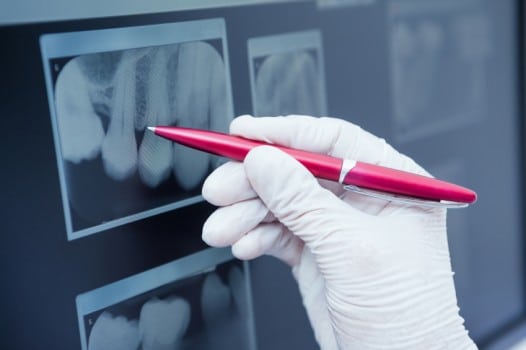Before the orthodontist puts your braces on, he will want to take X-rays, photos and impressions of your teeth.
X-rays are images that a beam of radiation creates when it passes through the body and hits a sensor on the other side. The images cast on digital film allow the orthodontist to view objects that are hidden by skin and bone.
Orthodontists are also dentists, and they take X-rays in order to identify any problems such as cavities in the teeth that need to be corrected before braces. They also take X-rays to examine the form and position of your teeth and jaw bones. They are especially looking for misshaped or misplaced teeth or roots, and jaw bones that are misaligned or asymmetrical.
Armed with this information, your orthodontist will generate a detailed treatment plan, which includes the type orthodontic appliances you will wear and how long you’ll need the braces.
In orthodontics, X-rays that generate images inside the mouth, known as intraoral, are most common. Several types are available based on the part of the jaw and teeth the orthodontist needs to examine. Most X-rays only capture only part of the mouth, so the orthodontist may take a series of images to examine multiple locations.
- Bitewing X-rays
show the position of the upper and lower teeth. The image reveals the health of the enamel, inner canals and roots. Enamel and fillings are dense and appear white in color, whereas the bones surrounding areas of decay are less dense and therefore appear darker. Orthodontists are trained to interpret the light and dark patterns to distinguish healthy teeth from damaged ones.
- Periapical X-rays
show the whole teeth from crown to root in one portion of the jaw. These images detect changes in the root and surrounding bone structures.
- Occlusal X-rays
track the development and placement of an entire arch of teeth in either the upper or lower jaw.
Another type of X-rays focus mainly on how the jaw is developed in relation to the teeth. Where intraoral X-ray films are placed inside the mouth, extraoral film is stored in the X-ray machine.
- Panoramic X-rays
capture a view of the entire mouth in a single image including the teeth, upper and lower jaws, tissues and surrounding structures. A panoramic X-ray allows your orthodontist to assess gum and bone irregularities that will help him plan for treatment.
- Tomograms
show a particular part the mouth while blurring out other areas. This type of X-ray is useful for examining structures that are difficult to see clearly because of an obstruction.
- Cephalometric projections
show the entire side of the head. This type of X-ray illustrates how the teeth and jaw relate to the mouth’s appearance from a side view.
Your orthodontist also will likely take sets of X-rays during your treatment to see how it is progressing, and after treatment to assess its outcome. The types of X-rays he will need depends on your treatment plan. However, all of these X-ray methods emit low levels of radiation—less than you would receive when being screened for an airline flight—and are very safe and free of side effects.
Orthodontic Associates offers all its patients state-of-the-art appliances, as well as revolutionary services and a wealth of orthodontic experience. You or your family member can choose from any of our nine convenient locations around Baltimore to set up your consultation. We look forward to making you smile!



